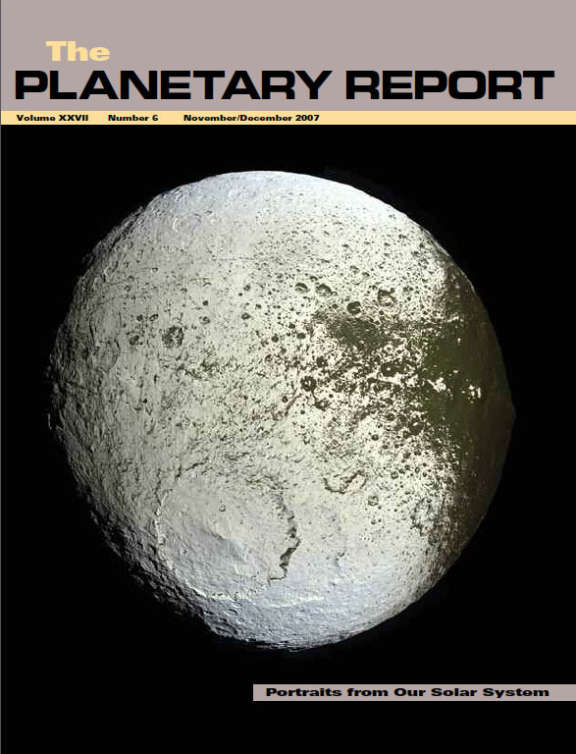The Planetary Report • November/December 2007
Portraits of our Solar System
On the Cover: Why one side of Iapetus is dark and the other side is bright has been a mystery since Giovanni Domenico Cassini discovered this Saturnian moon more than 300 years ago. Cassini's namesake spacecraft is now exploring the Saturn system on a primary mission that will include nearly 80 orbits of Saturn. <i>Cassini</i> swings by Titan on more than half these orbits and has frequent reasonably close encounter with most of the other moons. Iapetus orbits Saturn at three times Titan's distance, so <i>Cassini</i> had only one chance—on September 10, 2007—to swing out on a specially planned, highly elliptical distant orbit and view the yin-yang moon up close. <br \=""> This global portrait of the bright side of Iapetus shows the complexity of the boundary between the bright and dark material. Close inspection of the image reveals that there is no "gray" on Iapetus; moving from the dark to the bright regions, the dark stain on Iapetus' leading hemisphere breaks up into smaller and smaller patches, concentrated on crater floors and equator-facing crater walls.
Features
4 Worlds Beyond: Andre Bormanis looks at the next generation of spaceships.
10 A Night to Remember: The Planetary Society's 2007 Awards Ceremony: Andrea Carroll recounts the evening.
12 2007—The Year in Pictures: Emily Stewart Lakdawalla showcases 2007 in spectacular space images.
Departments
18 World Watch Government space programs in the U.S. and beyond, and the Lunar X PRIZE
19 Q&A Mars-crossing asteroids: What are the chances of impact?
19 Factinos Extrasolar planets; Rosetta views Earth
20 We Make it Happen! Bruce Betts gives an update on the Society's Optical SETI project
21 Members' Dialogue The future of space exploration
22 Society News New board members; Galaxy Garden opens in Hawaii
The Planetary Report • November/December 2007
Help advance space science and exploration! Become a member of The Planetary Society and you'll receive the full PDF and print versions of The Planetary Report.


 Explore Worlds
Explore Worlds Find Life
Find Life Defend Earth
Defend Earth


